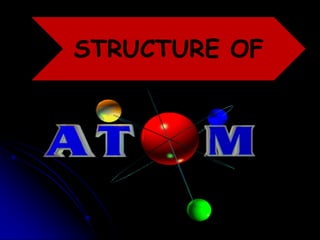
Module 2 atom inside out (grade 8)
- 1. STRUCTURE OF
- 2. EVIDENCE OF SUB ATOMIC PARTICLES
- 3. J.J. THOMSON 1856-1940 Discovered electron 1897 – Cathode Ray Experiment “Plum Pudding” model 1904 Electrons in a soup of positive charges Discovered isotopes 1913. Thomson’s experiments provided the first evidence that atoms are made of even smaller particles.
- 5. In 1886, He was one of the first to observe the proton (then unnamed). Discovered the positive charged – Canal Ray Experiment “Raising Pudding” model During his work with discharge tubes, he observed rays travelling from cathode to anode (electrons), and also noticed the presence of waves travelling in the opposite direction. These waves, called anode rays and having the lowest e/m ratio, were found to be characteristic of the gas in the tube.
- 6. CANAL OR ANODE RAY EXPERIMENT
- 8. Nucleus Theory 1910 “alpha particle gold-foil” experiment. Rutherford’s model states “All of an atom’s positive charge is concentrated in its nucleus.” An atom’s mass is mostly in the nucleus. He coined the word “Proton” for the smallest unit of positive charge in the nucleus.
- 10. In 1932, James Chadwick, an English physicist who had worked with Rutherford, detected neutrons and measured their mass in an invisible game of billiards. He bombarded beryllium atoms with alpha particles. An unknown radiation was produced. Chadwick interpreted this radiation as being composed of particles with a neutral electrical charge and the approximate mass of a proton. This particle became known as the neutron. With the discovery of the neutron, an adequate model of the atom became available to chemists.
- 12. Every Atom has a core called a nucleus. The Nucleus is largest part of an atom (about 99.9% of it’s mass) Within the nucleus are very small particles called protons and neutrons Electrons are in an orbit around the nucleus
- 13. Protons are the positively charged particles found inside the nucleus of an atom Every element has a unique atomic #. This # is the amount of protons inside that elements nucleus. Example: Oxygen has an atomic # of 8. How many protons does it have?
- 14. Negatively charged particles found orbiting around the nucleus Electrons are very small; only about 1/2000th the mass of a proton or neutron Electrons can move between atoms which causes bonds; this is how new compounds are formed.
- 15. Neutrons are the other particle found inside the nucleus of an atom Neutrons have no charge Atoms of a same element may not carry the same number of neutrons.
- 18. SHORTHAND NOTATION Element A Z P N e Charge Lithium 7 3 3 4 2 +1
- 19. Atoms that have the same number of protons, but have different numbers of neutrons. Examples: + - + - + - Hydrogen (Protium) Hydrogen (Deuterium) Hydrogen (Tritium)
- 21. SEATWORK ELEMENT charge A Z P N e 1. Boron 0 2. Nitrogen 0 3.Fluorine -1 4. Neon 0 5. Magnesium +2 6. Aluminum +3 7. Silicon 0 8. Sulfur 0 9. Potassium +2 10. Carbon -2
- 22. SCIENCE IDEAS Atom is regarded as the smallest, basic unit of matter. Even if it is the basic unit of matter, it is still composed of parts. The parts are the electrons (-), protons (+), and neutrons (0). An atom has equal number of protons and electrons. This makes the atom neutral. Protons and neutrons are relatively heavier than electrons. They compose the nucleus and collectively called as nucleons. The mass of an atom is mainly determined by the mass of the nucleus.
- 23. SCIENCE IDEAS: Several models have tried to show how the subatomic particles are arranged in an atom. Thus far, the accepted model places the protons and neutrons in the center of the atom; or the so-called, nucleus. Moving rapidly around the nucleus are the electrons. Atomic number, or the number of protons of an atom distinguishes an element from the others. This number is the same for all atoms of a particular element. While the number of protons is fixed for an atom of an element, the number of neutrons may vary. Atoms having the same number of protons but different number of neutrons are referred as isotopes. The isotopes are identified through their mass number which is the sum of the number of protons and the number of neutrons in an atom. Information on the subatomic composition of an element may be represented through shorthand notations.
- 24. Prepared by: JIMNAIRA U. ABANTO
